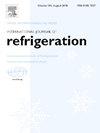Performance evaluation of low-temperature operated desiccant wheel integrated heat pump drying system for ponyfish (Leiognathus equula) drying
IF 3.5
2区 工程技术
Q1 ENGINEERING, MECHANICAL
International Journal of Refrigeration-revue Internationale Du Froid
Pub Date : 2025-02-06
DOI:10.1016/j.ijrefrig.2025.02.003
引用次数: 0
Abstract
Low-temperature drying is an effective technique for preserving the quality of heat-sensitive products such as fish. Integrating a desiccant wheel and a heat pump, the dryer can function at low temperatures and humidity levels while consuming less energy. This study evaluates the performance of a desiccant wheel integrated heat pump dryer (DW-HPD) for drying ponyfish (Leiognathus equula) at 40 °C, 45 °C, and 50 °C, emphasizing drying kinetics, dryer efficiency, mathematical models, and quality retention. The optimal drying temperature of 50 °C achieved the highest drying rate of 8.18 % wb/h. Increasing the temperature from 40 °C to 50 °C reduced the drying time from 10.5 to 5.5 h. Effective moisture diffusivity ranged from 8.40 × 10−10 to 1.87 × 10−9 m2/s, with an activation energy of 59.14 kJ/mol. The maximum specific moisture extraction rate (SMER) and specific energy consumption (SEC) were 2.21 kg/kWh and 9.4 kWh/kg at 50 °C, respectively. Rehydration ratio (RR) and water holding capacity (WHC) ranged from 1.172 to 1.183 and 0.336–0.406 g water/g dry solid. Water activity and texture values were 0.740–0.748 and 0.698–0.656 kg, respectively. The Hunter L* value indicated improved color quality, while sensory scores for overall acceptability at 45 °C and 50 °C ranged from "like moderately" to "like very much," confirming the high-quality standards of DW-HPD dried ponyfish.
马尾鱼低温干燥剂轮集成热泵干燥系统的性能评价
低温干燥是一种有效的技术,以保持热敏性产品,如鱼的质量。将干燥剂轮和热泵集成在一起,干燥机可以在低温度和低湿度水平下工作,同时消耗更少的能源。本研究评估了干燥剂轮集成热泵干燥机(DW-HPD)在40°C, 45°C和50°C下干燥马尾鱼(leognathus equula)的性能,强调干燥动力学,干燥效率,数学模型和质量保持。最佳干燥温度为50℃,干燥速率最高可达8.18% wb/h。温度由40℃升高至50℃,干燥时间由10.5 h缩短至5.5 h,有效水分扩散系数为8.40 × 10−10 ~ 1.87 × 10−9 m2/s,活化能为59.14 kJ/mol。在50℃条件下,最大比抽湿率(SMER)和比能耗(SEC)分别为2.21 kg/kWh和9.4 kWh/kg。复水比(RR)和持水量(WHC)分别为1.172 ~ 1.183和0.336 ~ 0.406 g水/g干固体。水分活度和织构值分别为0.74 ~ 0.748 kg和0.698 ~ 0.656 kg。Hunter L*值表明颜色质量有所改善,而在45°C和50°C下的整体可接受性感官评分从“中等”到“非常”,证实了DW-HPD干马鱼的高质量标准。
本文章由计算机程序翻译,如有差异,请以英文原文为准。
求助全文
约1分钟内获得全文
求助全文
来源期刊
CiteScore
7.30
自引率
12.80%
发文量
363
审稿时长
3.7 months
期刊介绍:
The International Journal of Refrigeration is published for the International Institute of Refrigeration (IIR) by Elsevier. It is essential reading for all those wishing to keep abreast of research and industrial news in refrigeration, air conditioning and associated fields. This is particularly important in these times of rapid introduction of alternative refrigerants and the emergence of new technology. The journal has published special issues on alternative refrigerants and novel topics in the field of boiling, condensation, heat pumps, food refrigeration, carbon dioxide, ammonia, hydrocarbons, magnetic refrigeration at room temperature, sorptive cooling, phase change materials and slurries, ejector technology, compressors, and solar cooling.
As well as original research papers the International Journal of Refrigeration also includes review articles, papers presented at IIR conferences, short reports and letters describing preliminary results and experimental details, and letters to the Editor on recent areas of discussion and controversy. Other features include forthcoming events, conference reports and book reviews.
Papers are published in either English or French with the IIR news section in both languages.

 求助内容:
求助内容: 应助结果提醒方式:
应助结果提醒方式:


